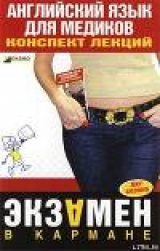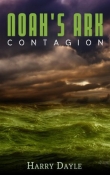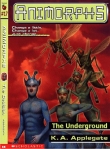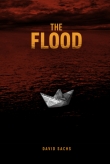
Текст книги "Английский язык для медиков: конспект лекций"
Автор книги: Елена Беликова
Жанры:
Языкознание
,сообщить о нарушении
Текущая страница: 8 (всего у книги 12 страниц)
ЛЕКЦИЯ № 27. Mechanics of breathing
Muscles of respiration: inspiration is always an active process. The following muscles are involved: The diaphragm is the most important muscle of inspiration. It is convex at rest, and flattens during contraction, thus elongating the thoracic cavity. Contraction of the external in-tercostals lifts the rib cage upward and outward, expanding the thoracic cavity. These muscles are more important for deep inhalations. Accessory muscles of inspiration, including the scalene (elevate the first two ribs) and sternocleidomastoid (elevate the sternum) muscles, are not active during quiet breath ing, but become more important in exercise. Expiration is normally a passive process. The lung and chest wall are elastic and naturally return to their resting positions after being actively expanded during inspiration. Expiratory muscles are used during exercise, forced expiration and cer tain disease states. Abdominal muscles (rectus abdominis, internal and exter nal obliques, and transversus abdominis) increase intra-abdominal pressure, which pushes the diaphragm up, forc ing air out of the lungs. The internal intercostal muscles pull the ribs downward and inward, decreasing the thoracic volume. Elastic properties of the lungs: the lungs collapse if force is not applied to expand them. Elastin in the alveolar walls aids the passive deflation of the lungs. Collagen within the pulmonary in-terstitium resists further expansion at high lung volumes. Compliance is defined as the change in volume per unit change in pressure (AV/AP). In vivo, compliance is measured by esophageal balloon pres sure vs. lung volume at many points during inspiration and expiration. Each measurement is made after the pressure and volume have equilibrated and so this is called static compli ance. The compliance is the slope of the pressure-volume curve. Several observations can be made from the pressure-volumecurve.
Note that the pressure-volume relationship is different with deflation than with inflation of air (hysteresis). The compliance of the lungs is greater (the lungs are more distensible) in the middle volume and pressure ranges.
At high volumes and expanding pressures, the compliance is lower (the lungs are stiffer). Even when the lung has no expanding pressure, some air remains in the lungs. When saline is used to fill the lung, compliance is much greater (small pressure changes bring about large changes in volume). With saline inflation, there is little difference in the pressure-volume relationship with inflation or defla tion. This indicates that the differences seen between infla tion and deflation of air must be due to surface forces in the air-liquid interface of the alveoli.
Causes of decreased compliance: pulmonary fibrosis, pulmonary venous congestion and edema, deficiency of surfactant. Causes of increased compliance: emphysema, age.
New words
muscles – мускулы, мышцы
respiration – дыхание
inspiration – вдох
always – всегда
process – процесс
following – следующий
to be involved – быть вовлеченным
diaphragm – диафрагма
the most – наиболее
important – важный
inspiration – вдохновение
convex – выпуклый
rest – отдых
to flattens – сглаживаться
contraction – сокращение
elongating – удлинение
the thoracic cavity – грудная впадина
the thoracic – грудная клетка
the rib cage -грудное ребро
upward – вверх
outward – наружу
expanding – расширение
volume – объем
compliance – согласие
some – некоторые
to remain – остаться
saline – солончак
to fill – заполняться
Сравните следующие предложения.
1. After dinner he drank some juice. – После обеда он выпил некоторое количество сока.
2. He does not drink milk after dinner, he drinks juice. – Он не выпил молока после обеда, а выпил сок.
3. I brought some books from the library. – Я взял некоторое количество книг в библиотеке.
4. I like books. – Я люблю книги.
Зставьте some, any, no или оставьте пропуски незаполненными, ориентируясь по смыслу.
1. There is… ink in my pen.
2. Is there. snow in the treet this morning?
3. My mother likes… musik.
4. Are there. chess-players here?
5. There are. diagrams in the new book.
6. Are there. newspapers on the table?
7. Was there. water in the glass or… milk?
8. There was. soap in the box; he used wash his hands.
9. There was. soap in the box: it smells of. soap.
10. There are… letters for you on the table.
11. Do you like… apples?
12. Were there. of our teachers at the stadium?
13. There were. students of our group at the consultation yesterday.
14. Will there be… concerts at the club next month?
15. There were. yellow and green pencils on the table.
16. People need… oxygen for breathing.
17. Are there. mistakes in my dictation?
18. There are. juice in your cup.
19. My brother doesn't like. carrots.
20. I have. books now.
Answer the questions.
1. Is inspiration always an active process?
2. What muscles are involved in the mechanism of breathing?
3. What muscle is the most important of inspiration?
4. What does contraction of the external intercostals lift?
5. What muscles are more important for deep inhalations?
6. What muscles are not active during quiet breathing?
7. Is expiration normally a passive process?
8. Are the lung and chest wall elastic?
9. Where are expiratory muscles used in?
10. Where do the internal intercostal muscles pull the ribs?
Make the sentences of your own using the new words (10 sentences).
Make your own sentences using SOME, ANY, NO, EVERY (10 sentences).
Find one word, which is a little bit different in meaning from others (найдите одно слово, которое немного отличается от других по смыслу):
1) a) air; b) muscles; c) organs;
2) a) eyes; b) brows; c) arms;
3) a) teeth; b) tongue; c) ligament;
4) a) coccyx; b) pelvis; c) shoulder;
5) a) elbow; b) arm; c) ear.
ЛЕКЦИЯ № 28. Surface tension forces
In a liquid, the proximity of adjacent molecules results large, inter-molecular, attractive (Van der Waals) forces that serve to stabilize the liquid. The liquid-air surface produces inequality of forces that are strong on the liquid side and weak on the gas side because of the greater distance between molecules in the gas phase. Surface tension causes the surface to maintain as small an area as possible. In alveoli, the result a spherically-curved, liquid lining layer that tends to be pulled inward toward the center of curvature of the alveolus. The spherical surface of the alveolar liquid lining behaves in manner similar to a soap bubble. The inner and outer surface of a bubble exert an inward force that creates a greater pressure inside than outside the bubble. Interconnected alveoli of different sizes could lead to collapse of smaller alveoli (atelectasis) into larger alveoli, because of surface tension, the pressure inside the small alveolus (smaller radius of curvature) is greater than that of the larger alveolus. Without surfactant, gas would therefore move from smaller to larger alveoli, eventually producing or giant alveolus.
Pulmonary surfactant: Pulmonary surfactant is a phospholipid (comprised primari ly of dipalmitoyl phosphatidylcholine) synthesized by type II alveolar epithelial cells. Surfactant reduces surface tension, thereby preventing the collapse of small alveoli. Surfactant increases the compliance of the lung and reduces the work of breathing.
Surfactant keeps the alveoli dry because alveolar collapse tends to draw fluid into the alveolar space. Surfactant can be produced in the fetus as early as gestational week 24, but is synthesized most abundantly by the 35 th week of gestation. Neonatal respiratory distress syn drome can occur with premature infants, and results in areas of atelec-tasis, filling of alveoli with transudate, reduced lung compliance, and V/Q mismatch leading to hypoxia and CO2 retention.
New words
surface tension forces – поверхностные силы напряжения
liquid – жидкость
proximity – близость
adjacent – смежный
large – большой
intermolecular – межмолекулярный
to stabilize – стабилизироваться
surface – поверхность
to produce – производить
side – сторона
weak – слабый
greater – больше
distance – расстояние
between – между
phase – фаза
tension – напряженность
spherically-curved – сферически-кривой
lining – выравнивание
inward – внутрь
toward – к
curvature – искривление
spherical – сферический
similar – подобный
soap – мыло
inner – внутренний
to exert – проявить
interconnected – связанный
something – что-нибудь, что-то
everything – все
Употребление something, anything, nothing или everything
1. Утвердительная форма:
I can see something on the table.
2. Отрицательная форма:
I can see nothing on the table. I cannot see any thing on the table.
3. Вопросительная форма:
Can you see anything on the table?
Вставьте something, anything, nothing или everything.
1… is all right, the patient is much better today.
2. Is there… interesting in the programme of the concert?
3. I could see…: it was quite dark.
4. Give me… to drink.
5. I didn't take any money with me, so I couldn't buy…
6. My new eyeglasses are very good, I can see… now.
7. I saw… near the wood that looked like a tent.
8. Give me… to read, please.
9. I don't know… about your town. Tell me… about it.
10. Please give me… warm: it is cold here.
11. I understand… now. Thank you for your explanation.
12. There is… white in the box. What is it?
13. Is there… that you want to tell me?
14. Where is the book? – It is on the table. – No, there is… there.
15. I know. about it.
16. Tell me. about your family.
Answer the questions.
1. What forces serve to stabilize the liquid?
2. What does the liquid air produces?
3. Where are the liquid – air forces strong and weak?
4. Why are the liquid – air forces strong and weak?
5. What does the surface tension cause?
6. Where the liquid lining layer tend to be pulled?
7. In what manner does the spherical surface of the alveolar liquid lining behave?
8. What creates a greater pressure inside than outside the bubble?
9. Where interconnected alveoli of different sizes could lead?
10. What is a pulmonary surfactant?
Make the sentences of your own using the new words (10 sentences).
Make your own sentences using something, anything, nothing everything (10 sentences).
Find one word, which is a little bit different in meaning from others (найдите одно слово, которое немного отличается от других по смыслу):
1) a) eyelashes; b) lips; c) eyelid;
2) a) skull; b) head; c) heart;
3) a) esophagus; b) vein; c) intestines;
4) a) knee; b) blood; c) vein;
5) a) capillaries; b) arteries; c) bones.
ЛЕКЦИЯ № 29. The nose
The respiratory system permits the exchange of oxygen and carbon dioxide between air and blood by providing a thin cellular membrane deep in the lung that separates capillary blood from alveolar air. The system is divided into a conduct ing portion (nasal cavity, pharynx, larynx, trachea, bronchi, bronchioles) that carries the gases during inspiration and expiration, and a respiratory portion (alveoli) that provides for gas exchange between air and blood.
The nose contains the paired nasal cavities separated by the nasal septum. Anteriorly, each cavity opens to the outside at a nostril (naris), and posteriorly, each cavity opens into the nasopharynx. Each cavity contains a vestibule, a respiratory area, and an olfactory area, and each cavity communicates with the paranasal sinuses.
Vestibule is located behind the nares and is continuous with the skin.
Epithelium is composed of stratified squamous cells that are similar to the contiguous skin.
Hairs and glands that extend into the underlying connective tissue constitute the first barrier to foreign particles entering the respiratory tract.
Posteriorly, the vestibular epithelium becomes pseudostratified, ciliated, and columnar with goblet cells (respiratory epithelium).
Respiratory area is the major portion of the nasal cavity.
Mucosa is composed of a pseudostratified, ciliated, columnar epithelium with numerous goblet cells and a subjacent fibrous lamina propria that contains mixed mucous and serous glands.
Mucus produced by the goblet cells and the glands is carried toward the pharynx by ciliary motion.
The lateral wall of each nasal cavity contains three bony pro jections, the conchae, which increase the surface area and pro mote warming of the inspired air. This region is richly vascularized and innervated.
Olfactory area is located superiorly and posteriorly in each of the nasal cavities.
The pseudostratified epithelium is composed of bipolar neu rons (olfactory cells), supporting cells, brush cells, and basalcells. The receptor portions of the bipolar neurons are modi fied dendrites with long, nonmotile cilia.
Under the epithelium, Bowman's glands produce serous fluid, which dissolves odorous substances.
Paranasal sinuses are cavities in the frontal, maxillary, ethmoid and sphenoid bones' that communicate with the nasal cavities.
The respiratory epithelium is similar to that of the nasal cavi ties except that it is thinner.
Numerous goblet cells produce mucus, which drains to the nasal passages. Few glands are found in the thin lamina propria.
New words
respiratory system – дыхательный аппарат
exchange – обмен
oxygen – кислород
carbon – углерод
dioxide – диоксид
cellular – клеточный
membrane – мембрана
deep – глубоко
capillary – капилляр
conduct ing – проведение
portion – часть
nasal cavity – носовая впадина
pharynx – зев
larynx – гортань
trachea – трахея
bronchi – бронхи
bronchioles – бронхиолы
inspiration – вдохновение
expiration – истечение
the paired – соединенный
nasal septum – носовая перегородка
anteriorly – раньше
nostril – ноздря
posteriorly – сзади
vestibule – вестибулярный
respiratory area – дыхательная область
olfactory area – обонятельная область
paranasal sinuses – параназальные пазухи
somebody – кто-нибудь, кто-то
Употребление somebody, anybody, nobody или everybody.
1. Утвердительная форма:
Не asked somebody to help him.
2. Отрицательная форма:
He asked nobody to help him. He did not ask any body to help him.
3. Вопросительная форма:
Did he ask anybody to help him?
Вставьте somebody, anybody, nobody или everybody.
1. Has… in this group got a dictionary?
2… left a magazine in our classroom yesterday.
3. The question was so difficult that… could answer it.
4. I am afraid I shan't be able to find… in the office now: it is too late.
5… knows that water is necessary for life.
6. Is there… here who knows French?
7. You must find… who can help you.
8… knew anything about America before Colum bus discovered it.
9. I saw… in the train yesterday who looked like you.
10. There is… in the next room. I don't know him.
11. Please tell us the sto ry… knows it.
12. Is there… in my group who lives in the dormitory?
13. Has… here got a red pencil?
14… can answer this question. It is very easy.
15. We haven't… black stockings.
16. They have… red boots, Kate.
17. I don't want… today
18. I haven't got… clean exercise-books. 19 We shall not buy… in this shx^
20. Didn't you buy… potatoes yesterday?
Answer the questions.
1. What does the respiratory system permit?
2. The exchange of what does the respiratory system permit?
3. What does the respiratory system provide deep in the lung?
4. What does separate capillary blood from alveolar air?
5. How is the respiratory system divided?
6. What does the nose contain?
7. What does each nasal cavity contain?
8. Where does each nasal cavity open to?
9. Where is vestibule located?
10. What is the major portion of the nasal cavity?
Make the sentences of your own using the new words (10 sentences).
Make the sentences of your own using somebody, anybody, nobody или everybody(10 sentences).
Find one word, which is a little bit different in meaning from others (найдите одно слово, которое немного отличается от других по смыслу):
1) a) digestion; b) nose; c) air;
2) a) cavity; b) nose; c) organ;
3) a) breath; b) nasal cavity; c) cartilage;
4) a) mouth; b) lip; c) ear;
5) a) oxygen; b) carbon; c) hydrogen.
ЛЕКЦИЯ № 30. Nasopharynx and larynx
Nasopharynx is the first part of the pharynx.
It is lined by a pseudostratified, ciliated, columnar.
Epithelium with goblet cells: under the epithelium, a gland-containing connective tissue layer rests directly on the periosteum of the bone.
The cilia beat towards the oropharynx, which is composed of a stratified, squamous, nonkeratinized epithelium.
The pharyngeal tonsil, an aggregate of nodular and diffuse lymphatic tissue, is located on the posterior wall of the nasopharynx subjacent to the epithelium. Hypertrophy of this tissue as a result of chronic inflammation results in a condition known as adenoiditis. Larynx is a passageway that connects the pharynx to the trachea and contains the voicebox. Its walls are composed of cartilage held together by fibroela-stic connective tissue.
The mucous layer of the larynx forms two pairs of elastic tissue folds that extend into the lumen. The upper pair are called the vestibu-lar folds (or false vocal cords), and the lower pair con stitute the true vocal cords. The epithelium of the ventral side of the epiglottis and of the vocal cords is composed of stratified, squamous, nonkeratinized cells. The remainder of the larynx is lined with ciliated, pseudostrati-fied, columnar epithelium. All cilia, from the larynx to the lungs, beat upward toward the nasopharynx.
New words
nasopharynx – носоглотка first – сначала
pseudostratified – псевдомногослойный
ciliated – снабженный ресничками
columnar – колоночный
epithelium – эпителий
goblet cells – кубические клетки
gland-containing – содержащий железу
connective tissue – соединительная ткань
layer – слой
directly – непосредственно
periosteum – надкостница bone – кость
cilia beat – ресницы бьются
oropharynx – верхняя часть глотки
stratified – стратифицированный
squamous – чешуйчатый
nonkeratinized – некеритизированный
somewhere – где-нибудь, куда-нибудь, где-то, куда-то
Употребление somewhere, anywhere, nowhere или everywhere
1. Утвердительная форма: I saw this man somewhere.
2. Отрицательная форма:
I saw this man nowhere. I did not see this man anywhere.
3. Вопросительная форма:
Did you see this I man anywhere?
Вставьте somewhere, anywhere, nowhere или everywhere.
1. I put my dictionary… yesterday.
2. I can't find my bag…
3. Of course, that is because you leave your books…
4. You must go… next summer.
5. Did you go… on Sunday?
6. Let's go…
7. I cannot find my glasses…
8. I always put me gloves… and then look for them for hours.
9. There are flags, banners and flowers… оп the streets.
10. I know that these books are.
11. Do you have… for breakfast?
12. I can find her.
Переведите на английский язык.
1. На столе что-то лежит.
2. Никто об этом ничего не знает.
3. В парке везде деревья и цветы.
4. В той комнате кто-то есть.
5. Марина живет где-то в центре.
6. Там никого нет.
7. У меня несколько друзей.
8. Я могу жить везде.
9. Где-то сейчас тепло.
10. Он нигде не мог найти красные розы.
Answer the questions.
1. What is the first part of the pharynx?
2. What is the nasopharynx lined by?
3. Where does a gland – containing connective tissue layer rest?
4. Where does the cilia beat?
5. What is oropharynx composed of?
6. What is located on the posterior wall of the nasopharynx?
7. What is the reason of adenoids?
8. What does the larynx connect?
9. What does the voicebox contain?
10. What is the voicebox composed of?
Make the sentences of your own using the new words (10 sentences).
Make the sentences of your own using somewhere, anywhere, nowhere или everywhere (10 sentences).
Find one word, which is a little bit different in meaning from others (найдите одно слово, которое немного отличается от других по смыслу):
1) a) nasopharynx; b) intestines; c) pharynx;
2) a) throat; b) trachea; c) feet;
3) a) Adam's apple; b) head; c) trachea;
4) a) lungs; b) coccyx; c) bronchi;
5) a) ear; b) tonsil; c) nose.
ЛЕКЦИЯ № 31. Trachea
The trachea, a hollow cylinder supported by 16-20 cartilaginous rings, is continuous with the larynx above and the branching primary bronchi below.
Mucosa of the trachea consists of the typical respiratory epitheli um, an unusually thick basement membrane, and an underlying lamina propria that is rich in elastin. The lamina propria contains loose elastic tissue with blood vessels, lymphatics, and defensive cells. The outer edge of the lamina propria is defined by a dense network of elastic fibers.
Submucosa consists of dense elastic connective tissue with serorilt-fcous glands whose ducts open onto the surface of the epithe lium.
Cartilage rings are C-shaped hyaline cartilage pieces whose free extremities point dorsally (posteriorly). They are covered by a pe-richondrium of fibrous connective tissue that surrounds each of the cartilages. Smooth muscle bundles (trachealis muscle) and ligaments span the dorsal part of each cartilage.
Adventita a consists of peripheral dense connective tissue that binds the trachea to surrounding tissues.
Primary bronchi
The trachea branches at its distal end into the two primary bronchi. Short extrapulmonary segments of the primary bronchi exist before they enter the lungs at the hilus and then branch further. The histologic structure of the walls of the extrapulmonary segment of the primary bronchi is similar to that of the tracheal wall.
New words
hollow – пустота
cylinder – цилиндр
supported – поддержанный
cartilaginous rings – хрящевые кольца
larynx – гортань
above – выше
branching – переход
primary bronchi – первичные бронхи
below – ниже
mucosa – слизистая оболочка
typical – типичный
respiratory epitheli um – дыхательный эпителий
an unusually – нетипитчно
thick – толстый
basement – основание
underlying – основной
lamina – тонкая пластинка
rich – богатый
elastin – эластин
loose – свободный
vessel – сосуд
lymphatics – лимфатический
defensive cells – защитные клетки
outer – внешний
edge – край
Много: MUCH, MANY, (A) LITTLE, (A) FEW
Единственное число: much (используется только исчисляемыми существительными).
Ex. I have much time.
Множественное число: many (используется только с неисчис-ляемыми существительными)
Ex. I have many books.
Переведите на английский язык следующие пары слов.
Много тетрадей, много молока, много воды, много дней, много газет, много мела, много снега, много лет, много картин, много музыки, много мальчиков, много девочек, много чая, много лимонов, много мяса, много комнат, много учителей, много работы, много воздуха, много птиц, много машин.
Вставьте much или many.
1. Please, don't put… peррег on the meat.
2. There were. plates on the table.
3. I never eat. bread with soup.
4. Why did you eat so. ice-cream?
5. She wrote us. letters from the coun try.
6… of these students don't like to look up words in the dictionary.
7.. in this work was too difficult for me.
8… of their answers were excel lent.
9..of their conversation was about the in stitute.
10. There are… new pictures in this room.
Answer the questions.
1. How many cartilaginous rings support the trachea?
2. What is the trachea continuous with?
3. What does mucosa of the trachea consist of?
4. What does the lamina propria contain?
5. With help of what is the outer edges of the lamina propria defined by?
6. What does submucosa consist of?
7. How are cartilage rings shaped?
8. What covers the cartilage rings?
9. What does adventitia consist of?
10. How do short extrapulmanory segments of the primary bronchi exist?
Make the sentences of your own using the new words (10 sentences).
Make the sentences of your own using MUCH, MANY, (A) LITTLE,
(A) FEW(10 sentences).
Find one word, which is a little bit different in meaning from others (найдите одно слово, которое немного отличается от других по смыслу):
1) a) vein; b) mucosa; c) trachea;
2) a) mucosa; b) organ; c) submucosa;
3) a) nerve; b) bone; c) organ;
4) a) brain; b) reflex; c) vertebra;
5) a) vision; b) eye; c) ear.








